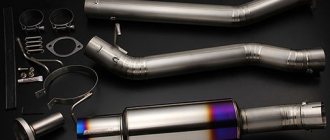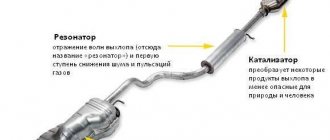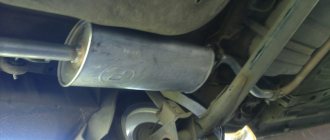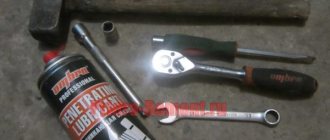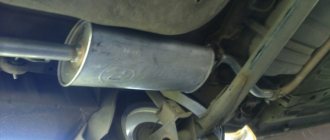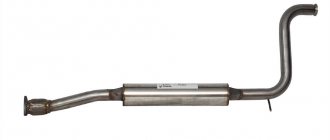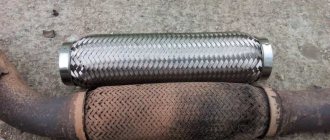Please write as the last comment, otherwise we are fighting in the middle)
ROADS FN2WATER, I THINK YOU SHOULD APPRECIATE...
So, by popular demand, I’m doing a full review of my custom exhaust...
LYRICAL DISTRACTION: My problem was that I absolutely did not want to pay 1000 euros for a piece of stainless steel and even drag it from somewhere, having arrived at one local tuning studio (a garage where they can weld pipes and make cans to order), we put the car on a lift and began to figure out how to save money)
ABOUT THE REGULAR EXHAUST The exhaust consists of a manifold + catalyst + resonator + muffler + 2 nut-like cans at the ends... Let's talk about them... Nuts)))) Heh) They are direct-flow cans, which on a standard exhaust give a bassy sound, that is, exhaust gases enter there they make us UUUUUUU! For this reason, the calculation was made that it was they, acting as reonators, that would eliminate the crackling noise that occurs when the pipe is straight...
OPERATION BALL! I love experiments)))) Especially if it concerns money)
1. Surgical intervention Ithax, we started... we cut off the muffler, we were left with 3 unconnected pipes, one thick one that goes from the resonator and 2 thin ones that lead to the “Nuts...” MMMMMmmmm...
2. Shop We went to a metal depot, where we bought - a thick pipe that went to the muffler (half the length of the muffler) with a corner (turn of the pipe) of the same size - and about a meter of thin pipes that go after the muffler, so what? - without them... 2 thin corners)
3.Building is more difficult than breaking... The most difficult thing in this process is the welding work, you need to make an adapter from 3 corners (2 thin and 1 thick), it is better to trust the professionals... It looks like this:
Next, just weld the pipes in the right places and you’re done...
It even slams, but not with fire, remember about the cat(((For those who don’t have enough volume, you can easily nibble on the resonator, but I think then it will be scary)))
If you don’t turn on the heat, the sound is quiet and a little bassy, in a word, you can pass traffic cops without paying attention...
llry is another bandit with such an exhaust)
A 100% investment pays off 5 times)
Forward flow is an opportunity to increase the power of a car’s engine, add aggressiveness to the car and improve jerkiness. You can assemble and install it yourself by studying the step-by-step instructions.
About direct flow or PG
A direct-flow muffler (PG) is an improved alternative to a stock exhaust, which is not capable of ensuring a quick and timely release of gases from the engine system (ICE). The standard exhaust system especially suffers (chokes) after installing a sports camshaft or after boring the cylinder head cylinders (in other words, on a forced engine).
A straight-through muffler is designed to improve the exhaust system
The GHG is designed to modernize the exhaust system, which increases gas emissions. In addition, a correctly installed PG will provide an increase in internal combustion engine power by 10–15 hp. However, you need to be prepared for drastic changes: everything will need to be replaced, from the catalyst to the tip.
Increasing the power of a power unit using a PG, unfortunately, also has a “other side of the coin”, associated primarily with a loud sound attack of about 120 dB. This is the norm for sports cars, but hardly for civilian ones. And this explains the mass of cases of fines issued by law enforcement inspectors to the owners of such cars.
To minimize this modernization flaw, craftsmen use various methods to reduce sound. Installing a flute muffler, oval or round resonator are all types of methods to improve the performance of a forward flow muffler. “Form and content” can make it quiet.
For example, craftsmen say that a square resonator installed in the middle of the path (the path for gases to escape into the aircraft) reduces noise much better than an oval or round one. And in general, it’s better not to use a round one, but to use an oval one as a last resort, since it has a larger volume of cans and, accordingly, a quieter sound.
Oval resonators from Volvo S60R and Saab have proven themselves to be quite good.
Before thoroughly understanding what GHG is, you should remember the functioning of the vehicle exhaust system. Many motorists do not even suspect how many tasks it performs, although it does not seem so at first glance.
The forward flow kit is a ready-made option for tuning
Of course, the main task of the exhaust is to remove gases. But an equally important function is to ensure timely and high-quality ventilation of the internal combustion engine cylinders.
How much does it cost to tune the exhaust sound?
Here are the prices for parts and services that affect the sound of the exhaust system. Check with a specialist for the exact cost of changing the exhaust sound of your car.
- Exhaust system made of aluminized steel from 18,000 rubles
- Stainless steel exhaust from 22,000 rubles
- Muffler corrugation from 450 rubles
- Catalysts from 3200 rubles
- Silencers from 3000 rubles
- Resonators (glass pack) from 3800 rubles
- Replacing the catalyst with a stronger/flame arrester/high-temperature resonator from 1,500 rubles
- Downpipe from 4900 rubles
- Bifurcation of the exhaust (exhaust pipes on two sides) from 7,500 rubles
- Sports catalysts from 4500 rubles
- Vacuum and electric dampers from 3500 rubles
- For individual tasks - by agreement. Check the cost with a consultant
Vacuum flap changes exhaust sound
See photos of exhaust systems in our gallery!
In addition to all of the above, the exhaust system increases throughput, and then the increase in power will occur even more efficiently. But let's not forget that not every person wants their car to have a bass sound from the exhaust system. Some people want a higher-pitched sound, some want a growling sound, some want a sound with shooting sounds, and others want to hear shooting shots and see flames behind them when accelerating sharply and releasing the gas, as if they are participating in an exciting film with chases and shooting. .
Each car owner has his own wishes, and it is precisely these desires that our Lyokha Exhaust is ready to fulfill with incredible quality and speed of work, we will make any of your wishes come true!
What is required to build an ASG (direct-flow exhaust system): tuning kit
Undoubtedly, installing a PG is a tuning, a modernization. And everything you need to build such a sporty exhaust option is available in stores.
The first is the resonator. Note that the sports PG does not have partitions that prevent the escape of gases. Its entire design is aimed only at ridding the internal combustion engine of excess gases generated during fuel combustion. As a result, power increases due to increased airflow.
Interesting point. On cars equipped with a naturally aspirated internal combustion engine, installing a sports PG allows you to increase power by 10 percent of the standard power, and on turbocharged cars - by 20 percent or even more.
The second necessary element, of course, is a new direct-flow flame arrester. The universal damper is intended as an alternative to the standard catalyst when constructing a direct flow. Such an element must be made of stainless steel (there is an option of aluminized steel). The internal part of such a flame arrester has a universal design, designed to increase the power of the machine’s power unit.
The structure of the muffler in the form of a diagram gives a complete picture of it
Fastening elements and other accessories, which must include various adapters, adapters, flanges, thermal tape for the exhaust manifold, etc., are also part of the system.
And finally, the muffler pipe, made of stainless steel or aluminized. The pipe itself must have an increased diameter (usually in the range of 38–76 mm). The length of the pipe is about 1000 mm, the wall thickness is 1.5 mm.
Come to Lyokha Exhaust for a new sounding exhaust system!
Our specialists will offer you the most suitable options based on your wishes, budget and diagnostic results, which must be done first and foremost if you are thinking about tuning your car. Diagnostics will help identify the most vulnerable spots in the exhaust pipe, and technicians will select the type and parts for tuning or repair. For our clients, diagnostics are carried out free of charge. We are always glad to see you at the address: Moscow, Sokolnichesky Val 1, cor. 1. We are always waiting for you at Lyokha Exhaust!
How to make a growling exhaust - photo, video, Instagram
Also, you can read Manufacturing of stainless steel exhaust pipes
Do-it-yourself PG from handy materials
If you can’t buy ready-made tuning kits from the store, then that’s okay. You can make a homemade muffler from handy materials. However, it is not recommended to use old, used mufflers for this, since as a result of repeated heating cycles, their metal loses its original properties.
Made of stainless steel
Stainless steel exhaust gas is the most expensive method of exhaust modernization, but also more effective. But if we also take into account the high levels of protection against aggressive environments, then this option can last for many years, and thereby save money.
To make a homemade PG from stainless steel, you need to do the following:
- take a stainless steel tube of the required diameter (the length is determined by the car model);
- put several metal brushes on it (sold in stores under the name “metal sponge”);
Metal brushes are designed in the direct-flow muffler to reduce noise
- wrap the pipe with sponges on with pieces of thin metal mesh;
Metal mesh is needed to wrap the direct-flow muffler and eliminate noise
- you need to wrap tightly so that there are no voids left (see photo);
Wrapping the muffler with a metal mesh should be done very tightly
- after wrapping, secure with wire (steel, not copper!);
- insert such a sandwich into a stainless steel pipe with a thicker diameter or wrap a stainless steel sheet over the wire;
- hammer ursa - mineral wool inside;
Exhaust sound tuning options
In order to understand what affects the exhaust sound, you first need to understand and decide what kind of sound you want: loud, quiet, bass, high, purring, seething, growling and many others.
In addition, controlled exhaust systems have been on the market for a very long time: active exhaust, hydraulic exhaust, pneumatic exhaust and electronic exhaust. All this allows you to make the exhaust of your car controllable. That is, when you are cutting through roads in the sunshine, everyone around can hear the roar of your four-wheeled friend, which can make the most incredible sounds. Or, late at night, in a residential area, you, as a decent citizen, will be able to drive your car almost silently, so as not to disturb anyone at a late hour.
At the Lyokha Exhaust service, we can make for you a constant sound from the car’s exhaust system, but we do not recommend doing this service, as the constant sound will quickly get boring. If you make the sound controllable, then you can drive so quietly, as if you were a wild animal on the hunt, and you can also make the sound so loud that it excites not only your blood, but also excites the blood of those around you! With just one button you increase the torque power and get a sharper acceleration of the car.
How to make a straight-through muffler quieter
The PG becomes quieter as it is collected. And each craftsman does this differently, using mineral wool, metal shavings, brushes or asbestos. It is also recommended to arrange several compartments inside the homemade muffler, creating additional resonance.
The installation of direct flow in various ways involves the use of mineral wool, shavings and other fillers
A car with an exhaust louder than 96 dB does not pass inspection, does not cross the border, and does not drive around the city. This is the law. Sound today is limited even in motorsport, where it would seem there should be no restrictions or boundaries.
Having decided to suppress the GHG, you need to understand that this should in no way affect the effectiveness of the new system. None of the components of the GHG system should create resistance to exhaust gases.
Flute
The flute or silencer in the PG is a simplified design used by tuners. Its task is to “calm down” the SG, obtaining legitimate dB at the output.
Making a flute is not difficult. It will be enough to use as a muffler a piece of a perforated 20-centimeter tube with a diameter that is slightly larger than the exhaust (by 1/3). A disk or conical washer must be fixed to the pipe to act as a plug. Fastening is carried out using bolts at the air cut. The washer, in fact, creates a structure that resembles a flute.
How to change the sound of the exhaust system: theory
By default, it removes exhaust gases. The smaller the diameter, the fewer gases will pass through it per unit time. Accordingly, the quieter the sounds it makes will be. With rolling sounds, everything should be exactly the opposite: a larger diameter and a larger volume of exhaust gases that exit into the pipe.
Limiters, reflectors, resonators and absorbers are responsible for reducing sound intensity. Due to the limiter, noise energy is dissipated when it overcomes the throttle resistance. Reflectors - internal partitions - reflect sound waves and create resistance to the flow of gases. Resonators dampen low frequency vibrations. And absorbers are analogues of sound insulation.
A thorough tuning will be required, but the main element that will be affected by the rework is the muffler. Remember: it is important to strike a balance between the loud, “growling” sound of forward flow and sound insulation. Then aesthetic pleasure from powerful sound is guaranteed!
How to get a straight-through muffler
You decided to make a bassy exhaust with your own hands. The first thing that is required is to convert the structure to a direct-flow one. The work takes place in three stages:
- dismantling the old muffler;
- preparation of the design basis;
- installation of direct flow and installation of insulation.
Now about each stage in more detail.
Removing elements of the old exhaust system
Carefully remove the muffler that is installed in the vehicle. It will probably be in a standard version, which guarantees a balance of power, sound, isolation - manufacturers rarely equip regular (non-sports) vehicles with anything else. Study the design of the exhaust system and think about how best to modify it to suit your needs.
Preparing the base for forward flow
You will still need the old muffler. Cut out its body and open it, then remove the internal filling. It is this that prevents you from getting that “roar” when driving at high speed, since it performs an isolating function.
Next, proceed to welding work. First, connect the old pipe with a new one purchased in advance. It is very important to choose a pipe with a diameter of about 20 cm. The increased diameter will allow a larger volume of exhaust gases to pass through its cavity, and this is what makes the sound booming. The new element should be welded into the housing remaining from the removed old exhaust system element.
Please note: visually the structure should look the same as before before dismantling. Otherwise, you will have problems securing the structure to the bottom. In the future, if you get into tuning at a professional level, there will be more opportunities for experimentation. The main material should be strong, heat-resistant steel - the temperature of the gases is very high and can damage a low-quality product made of thin steel.
Before moving on to how to make a bassy exhaust, take care of the appearance of the protruding part of the pipe. Many car owners find it unaesthetic. If you are one of them, use special attachments - they are sold in specialized stores.
Laying insulation
In order for the sound to be powerful, and the machine components located in the bottom area not to overheat due to the new pipe, it is necessary to use heat-resistant insulation. It is tightly wrapped around the welded structure, avoiding gaps. The following rule applies: the denser the insulation, the more growling the exhaust sound becomes. The insulation is additionally protected on top with a thin layer of stainless steel, and then tightened with steel clamps. The finished structure can be returned to the main place of work.
Installation of a resonator with an absorbing filler
Instead of the basic resonator, another one is installed, equipped with sound-absorbing material inside. Basalt fiber is most often used as a filler. This method is the most expensive.
To replace the resonator with a new one, you need to cut out the old part, insert the resonator with filler in its place and weld it on both sides.
Replacing the old resonator with a new one
Types of mufflers and their differences
There are 4 types of mufflers based on the method of absorbing acoustic waves:
- reflective;
- restrictive;
- absorption;
- resonator.
By design:
- straight-through;
- reverse flow
The reflective circuit is reverse-flow, the rest are direct-flow.
Reflective
If one muffler is installed in a car, then a reflective version is used. It uses the principle of “breaking” the flow of exhaust gases by creating several partitions, expansion chambers and turns. Exhaust volume is reduced to standard levels. For this reason, the vast majority of factory vehicles are equipped with the reflective type.
most popular for factory vehicle configuration
The disadvantage of this type of muffler is the reduction in engine power due to the resistance of the exhaust system to the flow of exhaust gases.
Resonator
A resonator muffler is installed as the first stage in the exhaust system of powerful engines. It consists of a perforated pipe placed in a housing. The body is divided into two or three sections. The energy of the exhaust gases is weakened due to a stepwise reduction in pressure.
installed as the first stage of exhaust energy suppression
The part reduces the force of sound vibrations and maintains engine power with a free flow of exhaust gases.
Restrictive
In restrictive mufflers, the gas flow passes through a diaphragm or cone narrowing, which leads to a decrease in engine power. The acoustic protection of such devices is low, since the diaphragm does not interfere with the rectilinear movement of the sound wave.
Absorption
The damping function for sound vibrations in the absorption muffler is performed by a finely porous non-flammable material located in the space between the perforated pipe and the housing. The design is similar to the resonator type. This type has little effect on power reduction.
